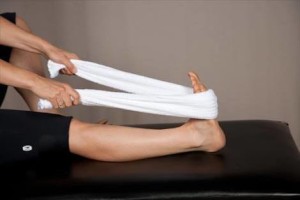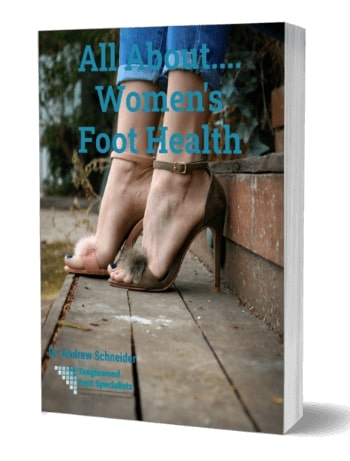No matter how much we talk about the troubles wearing high heels causes your feet, we know that women will continue to wear them. (Even though that includes bunions, shortened Achilles tendon, hammertoes and more. And even though women like Spanx founder Sara Blakely keep trying to find comfier alternatives, like these new high-heeled sneakers she just unveiled.)
So, in honor of the MANY new high-heels in your closet, we've decided to try joining ‘em instead of beating ‘em. To that end, we're sharing this six-step post-high-heel-wearing recovery plan. (It's inspired by iDiva.com and Occupational and Neurotherapist Dr Gundeep Singh.) Just don't forget to keep scrolling for a special workout to strengthen the muscles that take a beating when you rock those stilettoes. And for tips on preventing bunions with simple pedicure tools!
Heel Stretches for High Heels Recovery
If your feet hurt after slipping off those heels (or even if they don't yet) make these moves part of your post-stiletto routine.
1. Towel stretch:
This light stretch eases calf muscle pain. It also provides relief to the soles of your feet.

How to: Sit on the floor and stretch your legs out front. Bend your left leg and keep your right leg stretched. Use a towel to loop it around your foot and then pull your toes towards your body, while keeping your right knee straight.
Time: Hold for 10 seconds and repeat three times.
2. Wall-based heel stretches:
This stretch targets your calf muscles.
How to: Place both your hands on a wall and stand at arm's length. Keep your feet flat on the floor and then step forward with your right foot. The right foot should be about 25-30 cm away from the wall with your front knee bent and your back leg straight. Press your right knee towards the wall till you feel a stretch in your left calf muscles.
Time: Hold it for 10 seconds and relax. Repeat 3 times. Repeat the same with the left foot.
3. Stair-based heel stretches:
This exercise helps stretch your hamstring muscle, relieving the pain.
How to: Stand on the stairs in a way that your heels hang off of the bottom step. (Make sure you support your arches on the step.) Extend your arms at shoulder length and take support of the wall in front or on the side and hold the position. Keep the knee straight.
Time: Hold for 15 seconds and repeat five times.
4. The Water Bottle Stretch or Ball Roll:
This exercise is a very effective heel stretch for planter fasciitis (heel pain).
How to: Sit down on a comfortable chair or stand in an upright posture. Place a water bottle, tennis ball or rolling pin on the floor. Slowly roll the sole of your foot over the object. Start from the ball of your foot and move to the heel of your foot, across the plantar fascia.
Time: Do this for a minute. Repeat it for the other foot.
5. Squeeze your toes:
This helps strengthen the toes. It also eases your foot pain, especially if you have a hammer-toe.
How to: Separate your toes using foam or a separator and then squeeze your toes.
Time: Do this for five seconds and repeat 5-10 times.
Before we get to the last exercise, here's a side note on toe separators. (They're also called Yoga Toes in some circles.) Today, some runners swear that toe separators can boost recovery. They also think wearing them after training can prevent injury. Or even keep bunions and hammertoes from forming, because they realign your toes.
In the running community, people say these separators are magic. They wear them before bed, or on the way to races. Of course, there's no science to back up those claims. (Yet.) But if you want to try out this trend, there's very little downside. Simply start small. (Think 5-10 minutes of wearing in each session.) Then, work your way up to 30 minutes at a time. Steer clear of wearing them while you train, and you may experience benefits. And if they come, it won't be at the expense of your feet.
6. Contrast Bath:
This significantly improves muscle recovery.
How to: Place your feet in ice water followed by warm water.
Time: Immerse your feet for five minutes or for as long as you feel comfortable.
Now that you know what to do after you take off high heels, here's a workout to try before getting into them!

The Best Workout for High-Heel Lovers
We always devote space on this blog to reminders about the damage high heels can cause to women’s feet. That's why we won’t spend too much time reminding you that over-wearing stilettos can lead to bunions, hammertoes, foot pain and other complications…
Instead, we want to share this awesome new workout program. We first saw saw it on People.com. And we fell in love because it’s designed to fight high-heel pain!
Called the High Heel Rescue Workout, the program created by dancer Ilaria Cavagna uses two “Rescue Loops.” (These are sets of leather loops connected by a tension spring, that help work out your feet.) The program uses the loops in a series of movements that last 30 seconds to a minute each. All should help release tension and increase blood circulation in the feet.
Curious what this workout looks like? Check out one of the program’s signature moves:
Put the larger loops around the feet just below the joint of the little toe. Extend the legs, having the legs hip-width apart, which already engages the glutes when you lift, and you just pull out the toes lightly. The little movement connects the work of the ankle all the way to the hips. If you flex the foot more you elongate the posterior part [of the leg], which usually if you wear heels shortens because of the position of the ankle.”
Even if you don’t want to invest in Rescue Loops, there are many ways you can strengthen your feet and fight the effects of wearing high heels. It really doesn’t matter what you do, as long as you do something. After all, as Cavagna says: “Working out the feet is really, really important. I don’t think too many people know that. Getting them strong is important because they’re the foundation of our body. If your feet are in good health, the rest of the body is in good health and can stand properly.”
And if they aren't? That's where our podiatrist in Houston comes in to the picture. Make an appointment in my office at the first sign of a problem. We'll get you walking without pain. And with the least invasive treatments possible.


















